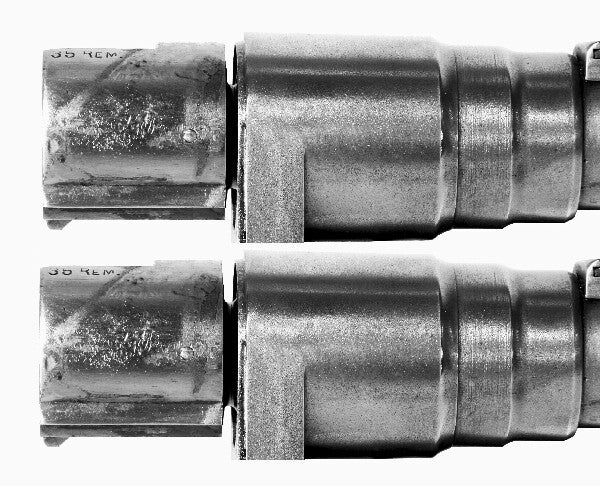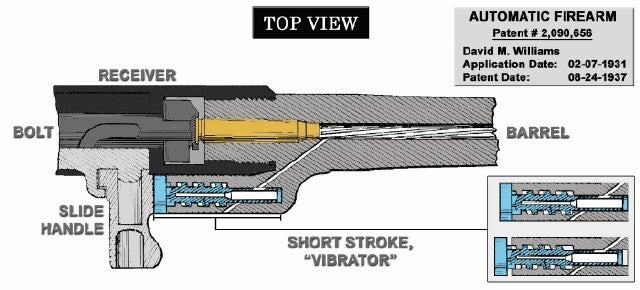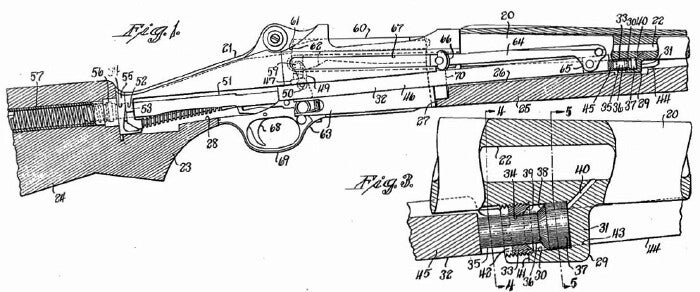If you haven’t read Part I, go ahead and follow the link.
A history of David Marshall Williams the man can be read at the excellent US Carbines website, and therefore I will not cover it here. I highly recommend clicking through to the site and reading it in its entirety.
While Williams’ was not the first person to come up with the tappet piston method of firearms operation, he did not know of any predecessor to his work, and it was his design that led to the production of tappet-operated firearms on a massive scale. In this article, I plan to cover one of the designs Williams’ made during his time in prison, as well as several weapons from before US entry into World War II, and a short description of each.
An important predecessor to the tappet gas system was Williams’ other significant invention, the floating chamber. An early iteration of this mechanism was applied by Williams to a Remington Model 8 recoil-operated rifle, to improve its operation. It is reasonable speculation to think that the Remington 8 itself might have inspired Williams’ to create the floating chamber, and later the tappet gas piston which is a logical derivative of it.

Williams’ floating chamber rifle, based on the Remington Model 8, in .35 Remington. This is regarded as the predecessor to his tappet operated firearms. Image source: uscarbines.com.

The extremely short stroke of the floating chamber “piston”, estimated at 1/15th of an inch. Image source: uscarbines.com.
Tappet operation as conceived by Williams seems to be a direct outgrowth of this project, as the original incarnation uses a similar threaded element to the floating chamber segment:

This (modern) colored panel derived from Williams’ patent for tappet operation betrays the floating chamber ancestry of the design. The “vibrator” is threaded, but does not rotate. Image source: uscarbines.com.
Once Williams had begun his work at Winchester, he set to improving Jonathon Browning’s (half-brother to John Moses Browning) G30 rifle, a rifle heavily influenced by and designed to complement the M1 rifle in the event of war. The G30M, as Williams’ modified version was called, would be echoed heavily in the design of the successful M1 Carbine. Williams would further lighten the rifle to an astounding 7.5 pounds, a variant which was designated G30R. Even the modern SCAR-H with a 13″ barrel clocks in at seven and three quarters pounds.

Winchester G30R rifle, redesigned from Jonathon Browning’s original design by David Marshall Williams. Image source: uscarbines.com.
It’s somewhat poorly known that while Williams did design a tappet operated carbine, he did not directly design the M1 Carbine itself. Edwin Pugsley, Winchester’s Chief of Engineering, realized that, despite his obvious genius, David Marshall Williams would not be able to finalize a design in time for the US carbine trials in May of 1941. Because of this, the Winchester carbine was designed, based off Williams’ work, by a team headed by William C. Roemer and Fred Humeston. The carbine strongly resembled the G30R rifle, and functioned in much the same way, as well. Williams did, however, demonstrate the carbine to Colonel René R. Studler* (some sources say Gen. Hodges), and after testing at Aberdeen, Army Ordnance determined that the Winchester carbine warranted further development.

Winchester’s first carbine prototype. While based on Williams’ work, Williams himself had nothing to do with the development of this weapon. Image source: uscarbines.com.
*This was the same Colonel Studler who was Chief of Small Arms R&D within the Ordnance Office during the early post-war small caliber high velocity experiments, until his retirement in 1953.
Continued in Part III: The M1 Carbine Cometh.
 Your Privacy Choices
Your Privacy Choices

